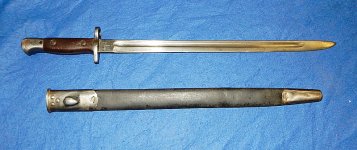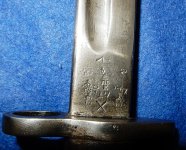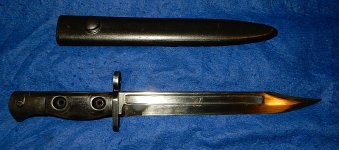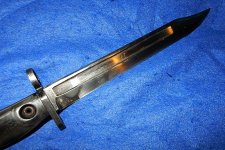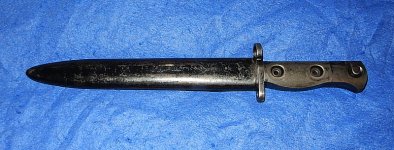As a proud Sheffielder who had many ancestors who were involved in the cutlery trades for which Sheffield is well known, I have over the years collected pen and pocket knives from my hometown. I never paid a huge amount for them unless they had a family name on them (Oldale, Trickett, Ellin, Barber etc) then I would pay more.
Since I've become housebound this particular collection has been pretty stagnant as I used to pick them up at boot sales and flea markets and not going out means no more pen & pocket knives.
That was until 2 weeks ago. I was doing some more work on my family tree when I came across a distant relative who on the 1881 census listed his occupation as 'bayonet finisher at Sanderson's Ltd'. This guy had been a pen & pocket knife maker all his life but in his declining years he was finishing bayonets as I suspect a sinecure for a once proud man
Anyway, this had me thinking it would be grand to have a bayonet or two in my collection so I started hunting.
Long story short, I ended up buying a Pattern 1888 Mk I bayonet made by Sanderson's. It is date stamped Nov 1894 and is an absolute corker. Quite short for a bayonet and made in the style of a Roman sword with a double edged blade with spear point. It has the UK government crow's foot, stamped with an X meaning it passed the bend test and a VR for queen Victoria.

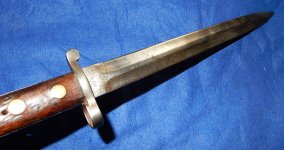
I then purchased a Pattern 1913 made by Remington in September 1917. This is unusual inasmuch as it was originally made for the British army under licence but when the US joined the war they needed them for their own troops. which is why this particular blade has the UK marks crossed through and a bold U.S. stamped on the ricasso with various other marks.
This blade has been Parkerized (dipped in phosphoric acid I think) to dull the surface. It's quite a whopper and is actually a sword bayonet. It has a wooden scabbard with a very neatly sewn leather covering.
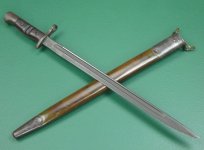

I wrongly assumed the two notches carved into the scales were evidence that it had been used at least twice but not so.
So far so good.....but I didn't stop there, I then ordered a couple of swords .
.
The first is an 1897 Officer's sword made by Fenton Brothers of Sheffield January 1915. It has a 32 1/2 " blade and the grip is wrapped in shagreen with neatly twisted copper wires. It has the royal cypher of King George V.

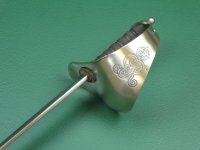
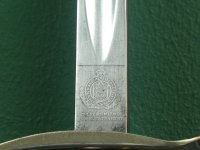
This was promptly followed by a sword from 1822-1830 (the reign of George IV). Apparently it's an infantry officer's sword with pipe back and quill tip. The blade has some stunning acid etching on it which has suffered by being polished by some twerp in the past but it's still visible. Alas this one came sans scabbard. Again, shagreen & copper wire decorate the handle. Considering it's 200 years old it's in remarkable condition.
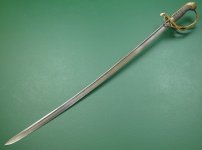
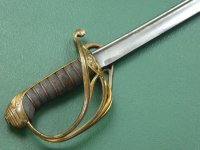
I'll post the other two bayonets later......I need a cuppa right now
Jay.
Since I've become housebound this particular collection has been pretty stagnant as I used to pick them up at boot sales and flea markets and not going out means no more pen & pocket knives.
That was until 2 weeks ago. I was doing some more work on my family tree when I came across a distant relative who on the 1881 census listed his occupation as 'bayonet finisher at Sanderson's Ltd'. This guy had been a pen & pocket knife maker all his life but in his declining years he was finishing bayonets as I suspect a sinecure for a once proud man
Anyway, this had me thinking it would be grand to have a bayonet or two in my collection so I started hunting.
Long story short, I ended up buying a Pattern 1888 Mk I bayonet made by Sanderson's. It is date stamped Nov 1894 and is an absolute corker. Quite short for a bayonet and made in the style of a Roman sword with a double edged blade with spear point. It has the UK government crow's foot, stamped with an X meaning it passed the bend test and a VR for queen Victoria.


I then purchased a Pattern 1913 made by Remington in September 1917. This is unusual inasmuch as it was originally made for the British army under licence but when the US joined the war they needed them for their own troops. which is why this particular blade has the UK marks crossed through and a bold U.S. stamped on the ricasso with various other marks.
This blade has been Parkerized (dipped in phosphoric acid I think) to dull the surface. It's quite a whopper and is actually a sword bayonet. It has a wooden scabbard with a very neatly sewn leather covering.


I wrongly assumed the two notches carved into the scales were evidence that it had been used at least twice but not so.
So far so good.....but I didn't stop there, I then ordered a couple of swords
The first is an 1897 Officer's sword made by Fenton Brothers of Sheffield January 1915. It has a 32 1/2 " blade and the grip is wrapped in shagreen with neatly twisted copper wires. It has the royal cypher of King George V.



This was promptly followed by a sword from 1822-1830 (the reign of George IV). Apparently it's an infantry officer's sword with pipe back and quill tip. The blade has some stunning acid etching on it which has suffered by being polished by some twerp in the past but it's still visible. Alas this one came sans scabbard. Again, shagreen & copper wire decorate the handle. Considering it's 200 years old it's in remarkable condition.


I'll post the other two bayonets later......I need a cuppa right now
Jay.






